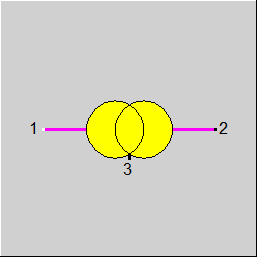

|
Line Connection |
|
|
|
1 |
Power Inlet |
|
|
2 |
Power Outlet |
|
|
3 |
Power Loss |
|
General User Input Values Physics Used Displays Example
Component 155 (Transformer) represents an electrical device used to change the voltage of a single or three-phase alternating current at constant frequency. The underlying physical model accounts for the iron losses (representing the losses due to eddy currents and hysteresis in the core of the transformer) and the copper losses (representing losses due to the resistance of the windings of the transformer). Using the approximation that the ratio of outlet voltage to inlet voltage is equal to the ratio of windings of the two circuits (i.e. neglecting the magnetizing current, which is a valid approach for power plant transformers), the respective exit current and power factor cos phi at the transformer outlet are determined.
For adapting the model to measured performance of a specific transformer, the physical model for off-design performance can be refined with a correction factor defined in a characteristic based on the ratio of apparent power under current and design conditions.
| FMODE |
Flag to set the calculation mode Design / Off-design =0: Global |
| FVOLT |
Method for specification of outlet voltage
|
| U2 | Outlet voltage |
| EFF |
Efficiency |
| LFFE |
Iron loss fraction (proportion of total losses) |
| FEFFOD |
Off-design efficiency method
|
|
QAPP1N |
Nominal apparent power |
|
LOSSN |
Nominal total losses |
|
LOSSFEN |
Nominal iron losses |
|
COSPHI2N |
Nominal outlet power factor |
| RLOAD | Apparent load fraction |
| REFF | Calculated efficiency |
| QLOSS | Calculated losses |
| LOSSFE | Iron losses |
| LOSSCU | Copper losses |
| QAPP1 | Apparent power at inlet |
| QAPP2 | Apparent power at outlet |
| QREAL2 | Calculated outlet power |
| QREACT2 | Calculated reactive outlet power |
| COSPHI1 | Calculated inlet power factor (cos phi1) |
| COSPHI2 | Outlet power factor (cos phi2 |
In the transformer model of component 155, the voltages U1 and U2 are assumed to be constant and independent of load. The model is also simplified in terms of neglecting the magnetizing current of the transformer. The underlying energy balances are shown in the section Equations below.
In design mode, the user has to specify
For the current input to the transformer will be
If data from the manufacturer are available, the component can also be sized by defining the nominal values for
In this case, the calculation mode FMODE must be set to the value of 1: "Local off-design".
The losses of the transformer are composed of iron losses and copper losses. Iron losses are assumed to be constant and independent of load, whereas the copper losses are related to the resistance in the copper windings and therefore have a quadratic correlation with the inlet current.
With the setting FEFFOD = 1, a correction term can be activated that uses the characteristic CFLOSSES for a correction factor as a function of the ratio of current inlet apparent power to nominal inlet apparent power.
|
All cases |
||
|
Energy balance: Q1 = Q2 + QLOSS = Q2 + LOSSFE + LOSSCU Q1 = I1 * U1 * COSPHI1 * SQRT(NPHAS) Q2 = I2 * U2 * COSPHI2 * SQRT(NPHAS) |
||
|
Design |
||
|
Loss calculation based on user input: LOSSN = (1-EFF )* Q1 LOSSFEN = LFFE * LOSSN LOSSCU = (1 - LFFE) * LOSSN I2 = (Q1 - LOSSN) / (U2 * COSPHI2 * SQRT(NPHAS)) QAPP2 = U2 * I2 * SQRT(NPHAS) I1 = I2 * (U2/U1) + LOSSFE / (U1 * SQRT(NPHAS)) QAPP1N = U1 * I1 COSPHI1 = (U2 * I2 + LOSSFEN) / (QAPP1N * SQRT(NPHAS)) |
||
|
Off-Design |
||
|
Losses depending on inlet current and apparent power at the inlet: LOSSFE = LOSSFEN (constant) LOSSCU = LOSSCUN * (I1/I1N)^2 QLOSS = (LOSSFE + LOSSCU) * CFLOSSES(QAPP1/QAPP1N); if FEFFOD=0 then CFLOSSES=1 COSPHI1 = (U2*I2 + LOSSFE) / (U1*I1 * SQRT(NPHAS)) |
||
Characteristic line 1 (CFLOSSES): loss correction factor = f (QAPP1/QAPP1N)
|
Characteristic line 1: power loss |
|
X-Axis 1 QAPP1/QAPP1N 1st point
. |
W. Plaßmann, D. Schulz (Hrsg.), Handbuch Elektrotechnik, Springer Fachmedien, Wiesbaden 2013
W. Weißgerber, Elektrotechnik für Ingenieure, Springer Fachmedien, Wiesbaden 2015
 |
Display Option 1 |
Click here >> Component 155 Demo << to load an example.